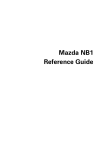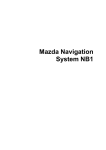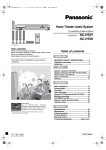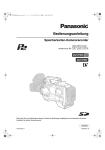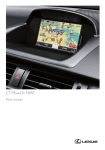Download Mazda GPS navigation Specifications
Transcript
'%'A0#8+A'0DQQMࡍࠫ㧞㧜㧝㧝ᐕ㧝㧜㧞㧡ᣣޓἫᦐᣣޓඦ೨㧝㧜ᤨ㧞㧤ಽ Contents Read me first 4 Switching on and off .......................................................................................................... 4 Setting up .......................................................................................................................... 4 GPS reception ................................................................................................................... 4 Device not starting............................................................................................................. 5 Take care of your device.................................................................................................... 5 Reference .......................................................................................................................... 5 The MAP SD card 6 About your MAP SD card .................................................................................................. 6 Inserting your MAP SD card .............................................................................................. 6 Removing your MAP SD card............................................................................................ 7 Safety Notice 8 Safety settings ................................................................................................................... 8 The commander 9 About the commander ....................................................................................................... 9 Using the commander ....................................................................................................... 9 Planning a route 10 Planning a route .............................................................................................................. 10 Route summary ............................................................................................................... 12 LIVE summary................................................................................................................. 12 Navigation menu options ................................................................................................. 13 Voice control 15 Voice control .................................................................................................................... 15 About navigation device voice control ............................................................................. 15 Using voice control .......................................................................................................... 16 Planning a journey using your voice ................................................................................ 17 The Driving View 18 About the Driving View .................................................................................................... 18 The Driving View ............................................................................................................. 18 Driving View Symbols...................................................................................................... 19 View map 20 About viewing the map .................................................................................................... 20 View map......................................................................................................................... 20 Options ............................................................................................................................ 22 1 '%'A0#8+A'0DQQMࡍࠫ㧞㧜㧝㧝ᐕ㧝㧜㧞㧡ᣣޓἫᦐᣣޓඦ೨㧝㧜ᤨ㧞㧤ಽ Map corrections 23 About Map Share............................................................................................................. 23 Sounds and voices 24 About sounds and voices ................................................................................................ 24 About computer voices .................................................................................................... 25 Selecting a voice ............................................................................................................. 25 Changing the volume level .............................................................................................. 25 Settings 26 About Settings ................................................................................................................. 26 Home location.................................................................................................................. 26 Favourites ........................................................................................................................ 26 Safety settings ................................................................................................................. 27 Show POI on map ........................................................................................................... 27 Switch map ...................................................................................................................... 28 Turn off voice guidance / Turn on voice guidance............................................................ 28 Help 29 About getting help............................................................................................................ 29 Using Help to drive to a local service .............................................................................. 29 Help menu options........................................................................................................... 29 Services 31 About LIVE Services ....................................................................................................... 31 Safety Notice ................................................................................................................... 31 Activating LIVE Services ................................................................................................. 31 LIVE Services subscriptions............................................................................................ 32 Traffic 33 About traffic information................................................................................................... 33 About TomTom HD Traffic ................................................................................................ 33 Using traffic information................................................................................................... 34 Speed cameras 35 Important ......................................................................................................................... 35 About Speed Cameras .................................................................................................... 35 Speed camera warnings.................................................................................................. 35 Changing the way you are warned .................................................................................. 36 Weather 37 About Weather................................................................................................................. 37 Requesting a weather report ........................................................................................... 37 2 '%'A0#8+A'0DQQMࡍࠫ㧞㧜㧝㧝ᐕ㧝㧜㧞㧡ᣣޓἫᦐᣣޓඦ೨㧝㧜ᤨ㧞㧤ಽ TomTom HOME 38 About TomTom HOME..................................................................................................... 38 Installing TomTom HOME ................................................................................................ 38 MyTomTom account......................................................................................................... 39 Updating your device ....................................................................................................... 40 Customer support 41 Getting help to use your navigation device...................................................................... 41 Status & information ........................................................................................................ 41 Addendum and Copyright 42 Addendum and Copyright................................................................................................ 42 Copyright notices 44 Software licenses 45 3 '%'A0#8+A'0DQQMࡍࠫ㧞㧜㧝㧝ᐕ㧝㧜㧞㧡ᣣޓἫᦐᣣޓඦ೨㧝㧜ᤨ㧞㧤ಽ Read me first Switching on and off Your Navigation Device switches on when your car starts and switches off automatically when you turn off your car's engine. Until a connection has been established between the Audio control unit and the Navigation Device, the screen shows audio-related information and the Nav button on the main display is inactive. In the case of restart of the navigation device, press the Nav button. A Mazda/ TomTom screen is shown and it may take up to 30 seconds for the main screen to appear. Under extreme temperature conditions, the navigation device may not start. When the temperature is within the normal range again, the device should start, if the device fails to start automatically in this situation, stop your car engine and start the car engine again. Note: In some situations, your navigation system may restart when turning your key in the ignition from ACC-ON to the engine start position. If this happens, it may take up to 30 seconds for the main screen to appear on the navigation system. Setting up Important: Take care to select the correct language as the language you choose will be used for all text on the screen. When you first switch on your device, you have to answer a few questions to set up the device. Answer the questions by tapping the screen. GPS reception When you first start your Navigation Device navigation device, the device may need a few minutes to determine your GPS position and show your current position on the map. In future, your position will be found much faster, usually within a few seconds. In areas where GPS reception is not possible, such as tunnels, your location may not be accurate. Important: The GPS antenna is located in the dashboard so do not put objects on the dashboard. 4 '%'A0#8+A'0DQQMࡍࠫ㧞㧜㧝㧝ᐕ㧝㧜㧞㧡ᣣޓἫᦐᣣޓඦ೨㧝㧜ᤨ㧞㧤ಽ Device not starting In rare cases, your TomTom navigation module may not start correctly or may stop responding to your taps. For example, if the device temperature is too high or too low, the system shuts down. In rare circumstances, you may need to reset your navigation device. To reset your device, switch off the car engine and then remove the MAP SD card. Re-insert the MAP SD card and switch the car engine on again. Take care of your device It is important to take care of your device as follows: Your device is not designed for use in extreme temperatures and any such exposure may cause permanent damage. Do not open the casing of your device under any circumstances. Doing so may be dangerous and will invalidate the warranty. Important: If you sell your car, you should remove all personal information from your navigation device first. To remove your personal information, tap Settings and then tap Reset factory settings. Reference Refer to online manual for full operations. Depending on the region in which the system is used, there may be differences in the functions/displayed specifications which can be used. 5 '%'A0#8+A'0DQQMࡍࠫ㧞㧜㧝㧝ᐕ㧝㧜㧞㧡ᣣޓἫᦐᣣޓඦ೨㧝㧜ᤨ㧞㧤ಽ The MAP SD card About your MAP SD card A MAP SD card is supplied with your navigation system. It includes a map of your country or group of countries. Updates are regularly produced by TomTom, particularly for maps and services like speed cameras. These updates are only available for download by inserting your navigation system's MAP SD card into a computer that is connected to the internet. Once your new vehicle has been delivered, if a newer version of your map is available within 60 days of first using your navigation device, you can download this map for free. Important: In order to qualify for the latest map guarantee you need to check if a new map is available within the 60 day period, and you are only entitled to one free map download. Inserting your MAP SD card To insert your MAP SD card into your Navigation Device in your car, do the following: 1. Switch off the ignition in the car so that the navigation system is switched off. 2. Open the sliding door and insert the MAP SD card, taking care to handle it carefully and that it is the right way round. Note: Only use your MAP SD card for operating and updating your navigation system. Do not insert the MAP SD card into another vehicle or into any other device such as a camera. 6 '%'A0#8+A'0DQQMࡍࠫ㧞㧜㧝㧝ᐕ㧝㧜㧞㧡ᣣޓἫᦐᣣޓඦ೨㧝㧜ᤨ㧞㧤ಽ Removing your MAP SD card To remove your MAP SD card from your Navigation Device in your car, do the following: 1. Switch off the ignition in the car so that the navigation system is switched off. 2. Slide the door open and push gently on the MAP SD card. 3. Remove the MAP SD card, taking care to handle it carefully. Use the SD card after the doors are securely closed. Switch the ignition off before inserting/ removing the SD card. Data is being writing on the SD card directly after the sliding doors are opened. Do not remove the SD card until the SD card removal authorization screen is displayed (about 3 seconds). When replacing the Navigation Device due to damage, it is necessary to update the SD card from TomTom Home so that the SD card information can be re-read. Consult your dealer for details. Please use only genuine Mazda SD card, and do not use other SD card In case the MAP SD card is damaged, personal data in MAP SD card are not guaranteed. In this case, the user can backup and restore your data using TomTom Home. Please refer to tomtom.com/services for details. 7 '%'A0#8+A'0DQQMࡍࠫ㧞㧜㧝㧝ᐕ㧝㧜㧞㧡ᣣޓἫᦐᣣޓඦ೨㧝㧜ᤨ㧞㧤ಽ Safety Notice Some TomTom navigation devices contain a GSM/GPRS module which can interfere with electrical devices such as cardiac pacemakers, hearing aids and aviation equipment. Interference with these devices may endanger the health or life of you or others. If your device includes a GSM/GPRS module, do not use it near unprotected electrical units or in areas where the use of mobile telephones is prohibited, such as hospitals and airplanes. Safety settings We recommend using the safety settings to make your driving as safe as possible. These are some of the options included in the safety settings: • Show safety reminders • Warn when driving faster than allowed If your device supports voice commands, you can also drive more safely by using voice commands to control your navigation device. Navigation operation - Avoid operating while driving. Operate after stopping the vehicle. - Do not focus your attention on the display while driving. Otherwise an accident could occur as a result of not paying attention to the road. - Always obey the traffic laws of the country in which the vehicle is being driven. 8 '%'A0#8+A'0DQQMࡍࠫ㧞㧜㧝㧝ᐕ㧝㧜㧞㧡ᣣޓἫᦐᣣޓඦ೨㧝㧜ᤨ㧞㧤ಽ The commander About the commander Important: The commander is only available for the European model. The commander is an input device located near the arm rest of your car in the central console. It has a central stick that you can move in the following ways: • Push in • Rotate left or right • Push the stick forwards or backwards • Push the stick left or right Using the commander Important: The commander is only available for the European model. 1. Push in - selects the item in focus, for example, the volume control when focused on the middle panel of the status bar in the Driving View. Switches items on or off. 2. Rotate left or right - operates slider bars, such as the volume control, and zoom in/out in the Driving View. 3. Push forward or back - moves the focus around the different areas of the screen or around the map when browsing. 4. Push left or right - moves you between pages in a menu or between tabs on a screen. Examples of how to carry out common tasks using the commander • To access the Main menu from the Driving View, push the button in. • To zoom in or out in the Driving View, use rotate right and left. • When focused on the map in the Driving View, push right to access the traffic menu. • When focused on the map in the Driving View, push left to access the quick menu. • When focused on the map in the Driving View, push back towards you to access the volume control in the centre panel of the status bar. • To access the Driving View from the Main menu, push the stick back towards you until you are focused on the Done button, then push the button in. • To move between letters on the keyboard screen, push left or right. Use push up or back to move to the letter above or below. You can also use rotate left or right to move between letters. 9 '%'A0#8+A'0DQQMࡍࠫ㧞㧜㧝㧝ᐕ㧝㧜㧞㧡ᣣޓἫᦐᣣޓඦ೨㧝㧜ᤨ㧞㧤ಽ Planning a route Planning a route Important: In the interest of safety and to reduce distractions while you are driving, you should always plan a route before you start driving. To plan a route on your Navigation Device, do the following: 1. Tap the screen to open the Main menu. 2. Tap Navigate to. 3. Tap Address. You can change the country or state setting by tapping the flag before you select a city. 4. Enter the town or city name. Tip: Instead of typing the address, tap the microphone button to enter the address by speaking to your Navigation Device. Towns with similar names are shown in the list while you type. When the correct city or town appears in the list, tap the name to select the destination. 5. Enter the streetname. Streets with similar names are shown in the list while you type. 10 '%'A0#8+A'0DQQMࡍࠫ㧞㧜㧝㧝ᐕ㧝㧜㧞㧡ᣣޓἫᦐᣣޓඦ೨㧝㧜ᤨ㧞㧤ಽ When the correct street name appears in the list, tap the name to select the destination. 6. Enter the house number, then tap Done. 7. The location is shown on the map. Tap Select to continue or tap Back to enter another address. Tip: If you want your final destination to be a car park, tap Car park and select a location from the list of car parks close to your general destination. 8. When the new route is shown, tap Done. For more information about the route, tap Details. 11 '%'A0#8+A'0DQQMࡍࠫ㧞㧜㧝㧝ᐕ㧝㧜㧞㧡ᣣޓἫᦐᣣޓඦ೨㧝㧜ᤨ㧞㧤ಽ To change your route, for example, to travel via a particular location or to select a new destination, tap Change route. Your Navigation Device starts to guide you to your destination, using spoken instructions and on-screen directions. Route summary The route summary shows an overview of your route, the remaining distance to your destination and the remaining estimated journey time. To view the route summary, tap the right-hand panel on the status bar in the Driving view or tap View route in the Main menu and then tap Show route summary. If you have a TomTom HD Traffic service or an RDS-TMC receiver, the route summary also shows traffic information about delays on your route. LIVE summary LIVE summary shows LIVE services information on your route. 12 '%'A0#8+A'0DQQMࡍࠫ㧞㧜㧝㧝ᐕ㧝㧜㧞㧡ᣣޓἫᦐᣣޓඦ೨㧝㧜ᤨ㧞㧤ಽ To view LIVE summary information, tap the LIVE tab on the route summary screen. Tap any of the panels for more detailed information. The LIVE tab panels show the following information: • Traffic on route - tap this panel to view detailed information about traffic delays and other incidents on your route. • Speed cameras - tap this panel to open the Speed Camera menu. You can then report a speed camera or change your settings for speed camera warnings. • Weather - tap this panel to view the latest weather reports. Note: LIVE services are not available in all countries or regions, and not all LIVE services are available in all countries regions. You may be able to use LIVE services when travelling abroad. For more information on available services, go to tomtom.com/services (see tomtom.com/services - http://www.tomtom.com/services). Navigation menu options When you tap Navigate to, you can set your destination in many ways, not just by entering the address. The other options are listed below: Tap this button to navigate to your Home location. You will probably use this button more than any other. Home Tap this button to select a Favourite as your destination. Favourite 13 '%'A0#8+A'0DQQMࡍࠫ㧞㧜㧝㧝ᐕ㧝㧜㧞㧡ᣣޓἫᦐᣣޓඦ೨㧝㧜ᤨ㧞㧤ಽ Tap this button to enter an address as your destination. Address Tap this button to select your destination from a list of places you have recently used as destinations. Recent destination Tap this button to navigate to a Point of Interest (POI). Point of Interest Tap this button to select a point on the map as your destination using the map browser. Point on map Tap this button to enter a destination using latitude and longitude values. Latitude Longitude Tap this button to use TomTom Local Search with Google to help you find shops and businesses in and around your current location. Note: Only available on LIVE devices. Local search You can choose to search for shops and businesses near you, near your destination, near any other destination or in a city. For example, if you are looking for a swimming pool near your current location, enter 'swimming pool' and choose the best search result. 14 '%'A0#8+A'0DQQMࡍࠫ㧞㧜㧝㧝ᐕ㧝㧜㧞㧡ᣣޓἫᦐᣣޓඦ೨㧝㧜ᤨ㧞㧤ಽ Voice control Voice control There are two types of voice control. The first type is provided by Mazda and you can read about it in the guide that came with your car. (Option) The second type is provided by your navigation device and you can use it to plan routes and control other features of your navigation device. You do this by initially tapping the screen on the navigation device. About navigation device voice control Note: Voice control is not supported on all devices or in all languages. Instead of tapping the screen to control your Navigation Device, you can use your voice to control your Navigation Device. For example, to increase the volume on your Navigation Device, you can say, "Increase volume" or "Volume 50%". To view the list of available commands, tap Help in the Main menu then tap Product manuals and then tap What can I say. Important: Voice control requires a computer voice. When there are no computer voices installed on your Navigation Device, this feature is not available. To select a computer voice, tap Voices in the Settings menu, then tap Change voice and select a computer voice. 15 '%'A0#8+A'0DQQMࡍࠫ㧞㧜㧝㧝ᐕ㧝㧜㧞㧡ᣣޓἫᦐᣣޓඦ೨㧝㧜ᤨ㧞㧤ಽ Using voice control Voice control is switched on by default if it is supported by your chosen language. The following example shows how to use voice control to plan a journey to your Home address: 1. Tap the microphone button in the Driving view to turn on the microphone. You see a screen with examples of commands you can say. Tap Help in the Main menu then tap Product manuals followed by What can I say to see a full list of commands you can say. When you hear "Say a command" followed by a tone, say a command of your choice. For example, you can say "Drive home". Your Navigation Device is only ready to listen after your hear the tone. While you are speaking the microphone monitor shows how well the device can hear your voice: A green bar means the device can hear your voice. A red bar means your voice is too loud for the device to recognise individual words. A grey bar means your voice is too quiet for the device to recognise individual words. For some phrases, your Navigation Device repeats what you say and asks for confirmation. Tip: For the best recognition of what you say, speak normally without trying to articulate words in an unnatural way. If there is excessive road noise, for example, you may need to speak in the direction of the microphone. 2. If the command is correct, say "Yes." If the command is incorrect, say "No" and repeat the command after you hear the prompt and tone again. Your Navigation Device plans a route from your current location to your destination. Tip: To stop your Navigation Device from listening out for further commands, say "Cancel". To go back one step, say "Back". 16 '%'A0#8+A'0DQQMࡍࠫ㧞㧜㧝㧝ᐕ㧝㧜㧞㧡ᣣޓἫᦐᣣޓඦ೨㧝㧜ᤨ㧞㧤ಽ Planning a journey using your voice Note: It's not possible to plan a route using your voice for all maps in all countries, or in all languages. You can navigate to any of the following types of places using your voice: • An address, including home. • Cities and towns and their centers. • Favourites. • POI categories. • POIs for named brands of, for example, restaurants, petrol stations, car rental and gyms. • A recent destination. To plan a route to an address using speech, do the following: 1. Tap the voice control button in the Driving view. 2. When you hear the tone, you can say, for example "Drive to an address". Tip: Your device has Navigate to on the button in the Main Menu. When planning a route to an address using speech, say "Navigate to address" if the button shows Navigate to. 3. Say the full address for your destination, for example, 112 James Street, London. Numbers can be pronounced naturally or one at a time. For example, 357 can be pronounced as "Three fifty seven" or "Three, five, seven". Your Navigation Device tells you what it heard. 4. Say "Yes" if the address is correct. If shown a list of addresses, say the list number for the correct address or say "none of these". If part of the address is incorrect, you can say something like "change the number", "change the street", "change the city" or "change the state" to correct the incorrect part. To begin again, say "start over". Your Navigation Device starts to guide you to your destination, using spoken instructions and onscreen directions. Tips: You can also use your voice to search for the nearest Point of interest (POI) category by saying something like "Drive to the nearest doctor". To select a Recent destination or a Favourite, say "Drive to a recent destination" or "Drive to a Favourite". 17 '%'A0#8+A'0DQQMࡍࠫ㧞㧜㧝㧝ᐕ㧝㧜㧞㧡ᣣޓἫᦐᣣޓඦ೨㧝㧜ᤨ㧞㧤ಽ The Driving View About the Driving View When your Navigation Device starts for the first time, you are shown the Driving View along with detailed information about your current position. Tap the centre of the screen at any time to open the Main Menu. The Driving View 1. Zoom button - tap the magnifying glass to show buttons for zooming in and out. 2. Quick menu - to enable the quick menu, tap Make your own menu in the Settings menu. 3. Your current position. 4. Road sign information or the next street name. 5. Traffic sidebar. Tap the sidebar to open the Traffic menu. The traffic sidebar is only shown if your device has either an HD Traffic subscription or an RDS-TMC Receiver connected. Traffic information is not available in all countries or regions. 6. Microphone button for voice command and control. 18 '%'A0#8+A'0DQQMࡍࠫ㧞㧜㧝㧝ᐕ㧝㧜㧞㧡ᣣޓἫᦐᣣޓඦ೨㧝㧜ᤨ㧞㧤ಽ 7. The time, your current speed and the speed limit, if known. To see the difference between your preferred arrival time and your estimated arrival time, check the Leeway checkbox in the Status bar settings. Note: Not all options may be available. Tap this part of the status bar to switch between a 3D map and a 2D map. 8. The name of the street you are on. 9. Navigation instruction for the road ahead and the distance to next instruction. If the second instruction is less that 150m after the first instruction, you see it shown immediately instead of the distance. Tap this part of the status bar to repeat the last voice instruction and to change the volume. You can also tap here to mute the sound. 1. The remaining journey time, the remaining distance and your estimated arrival time. Tap this part of the status bar to open the Route Summary screen. To change the information shown in the status bar, tap Status bar in the Settings menu. Driving View Symbols Sound muted - this symbol is shown when the sound has been muted. To turn the sound back on, tap the middle panel in the status bar. 19 '%'A0#8+A'0DQQMࡍࠫ㧞㧜㧝㧝ᐕ㧝㧜㧞㧡ᣣޓἫᦐᣣޓඦ೨㧝㧜ᤨ㧞㧤ಽ View map About viewing the map You can view the map in the same way as you might look at a traditional paper map. The map shows your current location and many other locations such as Favourites and POIs. To view the map in this way, tap View map or View route in the Main menu. You view different locations on the map by moving the map across the screen. To move the map, touch the screen and drag your finger across the screen. To select a location on the map, tap the location on the map. The cursor highlights the location and displays useful information about the location in an information panel. Tap the information panel to create a Favourite or plan a route to that location. View map Important: Not all features on this screen can be controlled using the commander. Use the touch screen instead. 1. The scale bar 2. Traffic - current traffic incidents. Use the Options button to select whether traffic information is shown on the map. When traffic information is shown on the map, POIs and Favourites are not shown. Note: To use a TomTom traffic information service, you may need a subscription. Traffic services are not supported in all countries or regions. For more information, visit tomtom.com/services (see tomtom.com/services - http://www.tomtom.com/services). 20 '%'A0#8+A'0DQQMࡍࠫ㧞㧜㧝㧝ᐕ㧝㧜㧞㧡ᣣޓἫᦐᣣޓඦ೨㧝㧜ᤨ㧞㧤ಽ 3. Marker Markers point to your current location (blue), your home location (yellow) and your destination (red). The marker shows the distance to the location. Tap a marker to centre the map on the location pointed to by the marker. You can also set your own marker. Tap the cursor button, then tap Set marker position to place a green marker at the cursor position. To turn markers off, tap Options, then Advanced and clear the Markers checkbox. 4. Options button 5. The cursor with street name balloon Tap the button in the street name balloon to open the cursor menu. You can navigate to the cursor position, make a Favourite of the cursor position, or find a Point of Interest near the cursor position. 6. The Find button Tap this button to find specific addresses, favourites or Points of Interest. 7. The zoom bar Zoom in and out by moving the slider. 21 '%'A0#8+A'0DQQMࡍࠫ㧞㧜㧝㧝ᐕ㧝㧜㧞㧡ᣣޓἫᦐᣣޓඦ೨㧝㧜ᤨ㧞㧤ಽ Options Tap the Options button to set the information shown on the map and show the following information: • Traffic - select this option to show traffic information on the map. When traffic information is shown, POIs and Favourites are not shown. Note: To use a TomTom traffic information service, you may need a subscription. Traffic services are not supported in all countries or regions. For more information, visit tomtom.com/services (see tomtom.com/services - http://www.tomtom.com/services). • Names - select this option to show street and city names on the map. • Points of interest - select this option to show POIs on the map. Tap Choose POI to choose which POI categories are shown on the map. • Satellite Images - select this option to show satellite images of the area being viewed. Satellite images are not available in every map or for every location on the map. • Favourites - select this option to show your Favourites on the map. Tap Advanced to show or hide the following information: • Markers - select this option to enable markers. Markers point to your current location (blue), your home location (yellow) and your destination (red). The marker shows the distance to the location. Tap a marker to centre the map on the location which the marker is pointing to. To create your own marker, tap the cursor button. Then tap Set marker position to place a green marker at the cursor position. To disable markers, tap Options, then tap Advanced and unselect Markers. • Coordinates - select this option to show GPS coordinates in the lower left corner of the map. 22 '%'A0#8+A'0DQQMࡍࠫ㧞㧜㧝㧝ᐕ㧝㧜㧞㧡ᣣޓἫᦐᣣޓඦ೨㧝㧜ᤨ㧞㧤ಽ Map corrections About Map Share Map Share helps you correct map errors. You can correct several types of map error. Note: Map Share is not available in all regions. For more information, go to tomtom.com/mapshare (see tomtom.com/mapshare http://www.tomtom.com/mapshare). 23 '%'A0#8+A'0DQQMࡍࠫ㧞㧜㧝㧝ᐕ㧝㧜㧞㧡ᣣޓἫᦐᣣޓඦ೨㧝㧜ᤨ㧞㧤ಽ Sounds and voices About sounds and voices Your Navigation Device uses sound for some or all of the following: • Driving directions and other route instructions • Traffic information Note: To use a TomTom traffic information service, you may need a subscription. Traffic services are not supported in all countries or regions. For more information, visit tomtom.com/services (see tomtom.com/services - http://www.tomtom.com/services). • Warnings that you set There are two types of voice available for your Navigation Device: • Computer voices (The voice accompanied with "Computer" in list is computer voice.) Computer voices are generated by your Navigation Device. They provide route instructions and read aloud city and street names, traffic and other useful information. • Human voices These are recorded by an actor and only provide route instructions. 24 '%'A0#8+A'0DQQMࡍࠫ㧞㧜㧝㧝ᐕ㧝㧜㧞㧡ᣣޓἫᦐᣣޓඦ೨㧝㧜ᤨ㧞㧤ಽ About computer voices Your Navigation Device uses text-to-speech technology and computer voices to read the street names on your map as it guides you on your route. The computer voice analyses the whole phrase or sentence before speaking, to ensure that the sentence sounds as close as possible to natural speech. Computer voices can recognise and pronounce foreign towns and street names. For example, the English computer voice can read and pronounce French street names. Note: Computer voices are not available in all languages. If you require a computer voice and your language is unavailable, then you need to install and use the English language computer voice. For more information on computer voices, go to tomtom.com/services (see tomtom.com/services http://www.tomtom.com/services). Selecting a voice To select a different voice on your Navigation Device, tap Voices in the Settings menu. Then tap Change voice and select the required voice. Changing the volume level You can change the volume on your Navigation Device in the Driving view.. • In the Driving view. Tap the central panel on the status bar and move the slider to adjust the volume. The last route instruction is played so you can hear the new volume level. 25 '%'A0#8+A'0DQQMࡍࠫ㧞㧜㧝㧝ᐕ㧝㧜㧞㧡ᣣޓἫᦐᣣޓඦ೨㧝㧜ᤨ㧞㧤ಽ Settings About Settings You can change the way your Navigation Device looks and behaves. Most of the settings on your device can be accessed by tapping Settings in the Main Menu. Home location Tap this button to set or change your Home location. You enter the address in the same way as you do when you plan a route. Your Home location provides an easy way to plan a route to an important location. Home location For most people, your Home location will be your home address. However, you might prefer to set the location to another regular destination, such as your workplace. Favourites Tap this button to add, rename or delete Favourites. Manage Favourites Favourites provide an easy way to select a location without the need to enter the address. They do not need to be favourite places, they can simply be seen as a collection of useful addresses. To create a new Favourite, tap Add. Then enter the location address in the same way that you enter an address when you plan a route. 26 '%'A0#8+A'0DQQMࡍࠫ㧞㧜㧝㧝ᐕ㧝㧜㧞㧡ᣣޓἫᦐᣣޓඦ೨㧝㧜ᤨ㧞㧤ಽ To view or change an existing Favourite, tap one of the items in the list. To see more Favourites on the map, tap the left or right buttons. Safety settings Tap this button to select the safety features you want to use on your Navigation Device. Safety settings Show POI on map Tap this button to select the types of Point of Interest (POI) you want to see on the map. 1. Tap Show POI on map in the Settings menu. Show POI on map 2. Select the POI categories you want to be shown on the map. Tap Search and use the keyboard to search for a category name. 3. Select whether you want POIs to be shown in 2D or 3D views of the map. 4. Tap Done. Point of Interest locations are shown on the map as symbols. 27 '%'A0#8+A'0DQQMࡍࠫ㧞㧜㧝㧝ᐕ㧝㧜㧞㧡ᣣޓἫᦐᣣޓඦ೨㧝㧜ᤨ㧞㧤ಽ Switch map Tap this button to select the map you want to use for route planning and navigation. Although you can store more than one map on the device, you can only use one map at a time for planning and navigation. Maps To switch from the current map to plan a route in another country or region, simply tap this button. Note: The first time you switch to a map, you may need to connect to your MyTomTom account and activate the map. Turn off voice guidance / Turn on voice guidance Tap this button to switch off voice guidance. You will no longer hear spoken route instructions but you will still hear information such as traffic information and warnings. Turn off Voice guidance Voice guidance is also switched off if you tap Turn off sound in the Settings menu. Note: If you change the voice on your Navigation Device, then voice guidance is automatically switched on for the new voice. Tap this button to switch on voice guidance and hear spoken route instructions. Turn on Voice guidance 28 '%'A0#8+A'0DQQMࡍࠫ㧞㧜㧝㧝ᐕ㧝㧜㧞㧡ᣣޓἫᦐᣣޓඦ೨㧝㧜ᤨ㧞㧤ಽ Help About getting help Tap Help in the Main Menu to navigate to emergency services centres and other specialist services. For example, if you are involved in a car accident, you could use the Help menu to find the contact details for the nearest hospital, call them using a phone and tell them your exact location. Using Help to drive to a local service To use Help to locate a service centre and navigate from your current location to the centre, do the following: 1. Tap the screen to show the Main Menu. 2. Tap Help. 3. Tap Drive to help. 4. Select the type of service you require, for example, Nearest hospital. 5. Select a centre from the list, the nearest is shown at the top of the list. Your Navigation Device shows a description of the location. 6. To navigate your way to the centre by car, tap Navigate there. Your Navigation Device starts guiding you to your destination. Help menu options Note: In some countries, information may not be available for all services. Tap this button to navigate your way by car to a service centre. Drive to help Tap this button to see your current location on the map. Where am I? 29 '%'A0#8+A'0DQQMࡍࠫ㧞㧜㧝㧝ᐕ㧝㧜㧞㧡ᣣޓἫᦐᣣޓඦ೨㧝㧜ᤨ㧞㧤ಽ Tap this button to read a selection of guides, including a First Aid guide. Safety and other guides Tap this button to read a selection of guides relating to your navigation device. Product manuals 30 '%'A0#8+A'0DQQMࡍࠫ㧞㧜㧝㧝ᐕ㧝㧜㧞㧡ᣣޓἫᦐᣣޓඦ೨㧝㧜ᤨ㧞㧤ಽ Services About LIVE Services The following LIVE services may be available for your device. LIVE services are subscriptionbased. • HD Traffic • Speed Camera • Weather • Local Search • QuickGPSfix™ Note: LIVE services are not available in all countries or regions, and not all LIVE services are available in all countries regions. You may be able to use LIVE services when travelling abroad. For more information on available services, go to tomtom.com/services (see tomtom.com/services - http://www.tomtom.com/services). Safety Notice Some TomTom navigation devices contain a GSM/GPRS module which can interfere with electrical devices such as cardiac pacemakers, hearing aids and aviation equipment. Interference with these devices may endanger the health or life of you or others. If your device includes a GSM/GPRS module, do not use it near unprotected electrical units or in areas where the use of mobile telephones is prohibited, such as hospitals and airplanes. Activating LIVE Services When you receive your car, you need to activate LIVE Services on your TomTom navigation device. This only has to be done once. To activate LIVE Services, do the following: 1. Tap Activate LIVE in the Main menu. 2. Follow the instructions to renew or extend your LIVE Services subscriptions if necessary. When activation is finished, you see the Main menu. LIVE Services are now ready for you to use. 31 '%'A0#8+A'0DQQMࡍࠫ㧞㧜㧝㧝ᐕ㧝㧜㧞㧡ᣣޓἫᦐᣣޓඦ೨㧝㧜ᤨ㧞㧤ಽ LIVE Services subscriptions Checking your LIVE Services subscription You can check the status of your subscriptions at any time. In the Main Menu, tap Services and then tap My Services. Your Navigation Device also warns you when your LIVE Services subscription is approaching the renewal date. For more information about LIVE Services subscription and payment terms, go to tomtom.com/services (see tomtom.com/services - http://www.tomtom.com/services). Renewing your LIVE Services subscription using your device 1. In the Main Menu, tap Services and then tap My Services. The current status of your LIVE Services is shown. 2. Tap on the service you want to renew. Your Navigation Device confirms that you want to renew your subscription. 3. Tap Yes. The renewal request is sent to TomTom. You should complete payment online, on or before the date shown on your Navigation Device. Renewing your LIVE Services subscription using TomTom HOME You can buy LIVE services as a pre-paid subscription using TomTom HOME as follows: 1. Start TomTom HOME on your computer. 2. Insert your MAP SD card into your card reader. 3. In TomTom HOME, click Add Traffic, Voices, Safety Cameras etc. 4. Click LIVE Services. You can then choose from LIVE Service bundles available via subscription in the online shop. Follow the onscreen instructions or use the HOME Help to get more information. In order to deliver products and services, such as downloadable maps and the LIVE services to you, as well as to offer you technical support, TomTom needs to use personal information related to you. TomTom adheres to the relevant privacy legislation and protects your personal information against misuse. In those cases where TomTom needs information about your location, we will ask you upfront for permission and allow you to withdraw your permission at any time. As a manual can only provide information accurate at the time of publishing, you can find all current and more detailed information on http://www.tomtom.com/legal/privacy. 32 '%'A0#8+A'0DQQMࡍࠫ㧞㧜㧝㧝ᐕ㧝㧜㧞㧡ᣣޓἫᦐᣣޓඦ೨㧝㧜ᤨ㧞㧤ಽ Traffic About traffic information You can receive traffic information in two ways: • TomTom HD Traffic • Traffic Message Channel (RDS-TMC) (All countries are not available.) Using traffic information, your Navigation Device can automatically adjust your route to minimise any delays. Note: LIVE services are not available in all countries or regions, and not all LIVE services are available in all countries regions. You may be able to use LIVE services when travelling abroad. For more information on available services, go to tomtom.com/services. About TomTom HD Traffic TomTom HD Traffic is a unique TomTom service providing real-time traffic information. For more information about TomTom services, go to tomtom.com/services (see tomtom.com/services - http://www.tomtom.com/services). In combination with IQ Routes, HD Traffic helps you plan the optimum route to your destination taking into account the current local traffic conditions. Your Navigation Device regularly receives information about the changing traffic conditions. If traffic jams or other incidents are found on your current route, your Navigation Device will offer to replan your route to try and avoid any delays. 33 '%'A0#8+A'0DQQMࡍࠫ㧞㧜㧝㧝ᐕ㧝㧜㧞㧡ᣣޓἫᦐᣣޓඦ೨㧝㧜ᤨ㧞㧤ಽ Using traffic information The traffic sidebar is shown on the right side of the Driving view. The sidebar informs you about traffic delays while you drive, using glowing dots to show you where each traffic incident is located on your route. The top of the traffic sidebar represents your destination and shows the total time delay due to traffic jams and other incidents on your route. The central section of the traffic sidebar shows individual traffic incidents in the order they occur on your route. The bottom of the traffic sidebar represents your current location and shows the distance to the next incident on your route. To make the traffic sidebar more readable some incidents may not be shown. These incidents will always be of minor importance and only cause short delays. The colour of the pointers, as shown below, gives you an instant indication of the type of incident: Unknown or undetermined situation. Slow traffic. Queueing traffic. Stationary traffic or road closure. 34 '%'A0#8+A'0DQQMࡍࠫ㧞㧜㧝㧝ᐕ㧝㧜㧞㧡ᣣޓἫᦐᣣޓඦ೨㧝㧜ᤨ㧞㧤ಽ Speed cameras Important Important: If you hear beeps and see no message on your screen, this is because you are in radio mode and the beeps are coming from your navigation device. The beeps are warning sounds given by the Speed Camera service to warn you of the presence of a speed camera. About Speed Cameras Note: LIVE services are not available in all countries or regions, and not all LIVE services are available in all countries regions. You may be able to use LIVE services when travelling abroad. For more information on available services, go to tomtom.com/services (see tomtom.com/services - http://www.tomtom.com/services). The Speed Cameras service warns you about the following roadside camera locations: • Speed camera locations. • Accident blackspot locations. • Mobile speed camera locations. • Average speed camera locations. • Toll road camera locations. • Traffic light camera locations. Speed camera warnings By default, warnings are given 15 seconds before you reach a speed camera location. To change the number of seconds or warning sound, tap Alert settings in the Speed Cameras menu. You are warned in three ways: • Your device plays a warning sound. • The type of speed camera and your distance from the camera location is shown in the Driving View. If a speed restriction has been reported for the camera, the speed is also shown in the Driving View. • The location of the speed camera is shown on the map. Note: For average speed cameras, you are warned by a combination of icons and sounds at the start, middle and end of the average speed check zone. 35 '%'A0#8+A'0DQQMࡍࠫ㧞㧜㧝㧝ᐕ㧝㧜㧞㧡ᣣޓἫᦐᣣޓඦ೨㧝㧜ᤨ㧞㧤ಽ Changing the way you are warned To change the way your Navigation Device warns you about speed cameras, tap the Alert settings button. You can then set how close you want to be to a speed camera before you are warned and what type of sound will be played. Alert settings For example, to change the sound that is played when you approach a fixed speed camera, do the following: 1. Tap Services in the Main Menu. 2. Tap Speed Cameras. 3. Tap Alert settings. A list of speed camera types is displayed. A speaker is shown next to the speed camera types that have been set for an alert. 4. Tap Fixed cameras. 5. Tap NO to avoid removing the fixed speed camera alerts. 6. Enter the time in seconds for when a warning is given before you reach a camera. Then tap Next 7. Tap the sound you want to be used for the warning. Tips: To switch off warning sounds for a camera type, tap Silence in step 7 above. You still see a warning in the Driving View if you switch off the warning sound. 8. Tap Done to save your changes. 36 '%'A0#8+A'0DQQMࡍࠫ㧞㧜㧝㧝ᐕ㧝㧜㧞㧡ᣣޓἫᦐᣣޓඦ೨㧝㧜ᤨ㧞㧤ಽ Weather About Weather Note: Only available on LIVE devices. The TomTom Weather service provides detailed weather reports and 5-day weather forecasts for towns and cities. The information is provided by local weather stations and is updated hourly. Note: For more information on available services, go to tomtom.com/services. Requesting a weather report To request a weather report for a specific location, such as the town or city for your final destination, do the following: 1. Tap Services in the Main Menu. 2. Tap Weather. 3. Tap Weather near you or Weather near destination to go directly to a weather summary. 4. Tap Weather near other location to choose your location using, for example, an address, Home, a Favourite or a POI. A summary weather report for that location is shown. Tap on any day of the week for a detailed weather report. 37 '%'A0#8+A'0DQQMࡍࠫ㧞㧜㧝㧝ᐕ㧝㧜㧞㧡ᣣޓἫᦐᣣޓඦ೨㧝㧜ᤨ㧞㧤ಽ TomTom HOME About TomTom HOME Using TomTom HOME you can register and manage your navigation device to receive free updates and buy new services. It's a good idea to connect frequently to HOME so you can do the following: • Download for free the most recent map available for your device, if you connect to TomTom HOME within 60 days of buying your device. • Download for free updates for your device, including Map Share updates and other services included with your product. • Add new items to your device, like maps, voices and POIs, as well as buy TomTom services and manage your subscriptions. • Share your map corrections and other content with the TomTom community. • Make and restore backups of your device. When using HOME, you can get help with what you are doing from the HOME Help. You can also read about all the other things that HOME can do for you. Tip: We recommend using a broadband internet connection whenever you connect to HOME. Installing TomTom HOME The steps below refer to Internet Explorer on Windows XP. If you're using another browser or operating system, visit tomtom.com/support (see tomtom.com - http://www.tomtom.com) for more information. To install TomTom HOME on your computer, do the following: 1. Connect your computer to the internet. 2. Go to the link below to download the latest version of TomTom HOME: tomtom.com/home (see tomtom.com/home - http://www.tomtom.com/home) 3. We recommend downloading the file to your computer by clicking Save. 4. Once the download is complete, click Open. 5. If you accidentally closed the Download complete window, locate the file TomTomHOME2winlatest.exe on your computer and double-click it. 6. If you get a security warning click Run. 7. Click Next, then click Install. The installation starts. 8. Once the installation is complete click Finish. 38 '%'A0#8+A'0DQQMࡍࠫ㧞㧜㧝㧝ᐕ㧝㧜㧞㧡ᣣޓἫᦐᣣޓඦ೨㧝㧜ᤨ㧞㧤ಽ MyTomTom account To download content and services using TomTom HOME, you need a MyTomTom account. You can create an account when you start using TomTom HOME. Note: If you have more than one TomTom device, you need a separate MyTomTom account for each device. If you have a MyTomTom account, you can access the following benefits online using HOME or by using the MyTomTom section of tomtom.com: • Services - click Services on the TomTom website to subscribe to services such as realtime traffic and safety camera information. • Newsletters - click MyTomTom followed by Account details on the TomTom website to manage newsletter subscriptions and language preferences for product news • Support - click My Questions on the TomTom website to track and view your case history and all email conversations you have with TomTom about technical support issues via the website. You can also update cases with new information. • Orders - click My Orders on the TomTom website to view items you ordered from the TomTom website and your order history. • TomTom Map Share - report and download map corrections by joining the Map Share community using HOME. You can then benefit from shared reporting of map issues such as missing streets and wrong driving instructions. • Downloads - download free items using TomTom HOME. 39 '%'A0#8+A'0DQQMࡍࠫ㧞㧜㧝㧝ᐕ㧝㧜㧞㧡ᣣޓἫᦐᣣޓඦ೨㧝㧜ᤨ㧞㧤ಽ Updating your device Before you start, make sure you have a backup of your device or MAP SD card. For more information, see Backing up your navigation device. You can check for updates for your maps, services and for a whole range of other free items or items for purchase. The instructions below describe how to update the TomTom application on your device. To check for an updated application version do the following: 1. Insert your MAP SD card into the card reader connected to your computer. 2. Wait for TomTom HOME to start. 3. If HOME does not automatically check for updates, click Update my device in the HOME menu. Note: if you would like to install an application you downloaded previously, click Add Traffic, Voices, Safety Cameras etc. > Items on my computer. 4. If a new application is available, it is listed on the next screen. 5. Make sure the new application is selected, then click Download updates. HOME downloads the selected items... 6. HOME then installs the selected items on your MAP SD card. 7. Click Done. 8. Click Device > Disconnect Device in the HOME menu. You can then disconnect your card from your computer. 40 '%'A0#8+A'0DQQMࡍࠫ㧞㧜㧝㧝ᐕ㧝㧜㧞㧡ᣣޓἫᦐᣣޓඦ೨㧝㧜ᤨ㧞㧤ಽ Customer support Getting help to use your navigation device You can get further help by going to tomtom.com (see tomtom.com - http://www.tomtom.com) and clicking Support. For warranty information, go to tomtom.com/legal (see tomtom.com/legal http://www.tomtom.com/legal). Status & information Tap this button to open the Status & information menu. Status & Information Tap this button to view technical information about your device, such as your serial number for your device and the TomTom App version. Version information Tap this button to see the current status for GPS reception. GPS Status Tap this button to check the status of your subscriptions to TomTom Services. Note: Only available on LIVE devices. My Services 41 '%'A0#8+A'0DQQMࡍࠫ㧞㧜㧝㧝ᐕ㧝㧜㧞㧡ᣣޓἫᦐᣣޓඦ೨㧝㧜ᤨ㧞㧤ಽ Addendum and Copyright Addendum and Copyright Federal Communications Commission (FCC) Statement (US) THE DEVICE COMPLIES WITH PART 15 OF THE FCC RULES Radio and Television Interference: This equipment radiates radio frequency energy and if not used properly - that is, in strict accordance with the instructions in this manual - may cause interference to radio communications and television reception. This device has been tested and found to comply with the limits for a Class B digital device, pursuant to Part 15 of the FCC Rules. These limits are designed to provide reasonable protection against harmful interference in a residential installation. This equipment generates, uses and can radiated radio frequency energy and, if not installed and used in accordance with the instructions, may cause harmful interference to radio communications. However, there is no guarantee that interference will not occur in a particular installation If this equipment does cause harmful interference to radio or television reception, which can be determined by turning the equipment off and on, the user is encouraged to try to correct the interference by one or more of the following measures: • Reorient or relocate the receiving antenna. • Increase the separation distance between the equipment and the receiver. • Connect the equipment into an outlet on a circuit different from that to which the receiver is connected. • Consult an experienced radio/TV technician for help. Changes or modifications not expressly approved by the party responsible for compliance could void the user's authority to operate the equipment. Important This equipment was tested for FCC compliance under conditions that included the use of shielded cables and connectors between it and the peripherals. It is important that you use shielded cable and connectors to reduce the possibility of causing radio and television interference. Shielded cables, suitable for the product range, can be obtained from an authorized dealer. If the user modifies the equipment or its peripherals in any way, and these modifications are not approved by TomTom, the FCC may withdraw the user's right to operate the equipment. For customers in the USA, the following booklet prepared by the Federal Communications Commission may be of help: "How to Identify and Resolve Radio-TV Interference Problems". This booklet is available from the US Government Printing Office, Washington, DC 20402. Stock No 004-000-00345-4. 42 '%'A0#8+A'0DQQMࡍࠫ㧞㧜㧝㧝ᐕ㧝㧜㧞㧡ᣣޓἫᦐᣣޓඦ೨㧝㧜ᤨ㧞㧤ಽ FCC Declaration of Conformity Tested to Comply with FCC Standards for Home or Office Use This device complies with part 15 of the FCC Rules. Operation is subject to the following two conditions: 1. This device may not cause harmful interference. 2. This device must accept any interference received, including interference that may cause undesired operation. Responsible party in North America TomTom, Inc., 150 Baker Avenue Extension, Concord, MA 01742 Tel: 866 486-6866 option 1 (1-866-4-TomTom) There is no emergency call possible with this device. (Australia/New Zealand) CE Marking (EU) This equipment complies with the requirements for CE marking when used in a residential, commercial, vehicular or light industrial environment, achieving all the appropriate provisions of the relevant legislation in the EU. 0682 R&TTE directive (EU) Hereby, TomTom declares that TomTom personal navigation devices and accessories are in compliance with the essential requirements and other relevant provisions of the EU Directive 1999/5/EC. The declaration of conformity can be found here: www.tomtom.com/legal. Connected networks (EU, USA) Devices that contain a GSM module are intended for connection to the following networks: GSM/GPRS 900/1800 Exposure limits (EU/Aus/NZ - LIVE product) This device complies with radiation exposure limits set forth for an uncontrolled environment. In order to avoid the possibility of exceeding the radio frequency exposure limits, human proximity to the antenna shall not be less than 20 cm (8 inches) during normal operation. Model names 1MI00; 1MI01; 1MI011 43 '%'A0#8+A'0DQQMࡍࠫ㧞㧜㧝㧝ᐕ㧝㧜㧞㧡ᣣޓἫᦐᣣޓඦ೨㧝㧜ᤨ㧞㧤ಽ Copyright notices © 2011 TomTom N.V., The Netherlands. TomTom®, and the "two hands" logo, among others, are Trademarks owned by TomTom N.V. or one of its subsidiaries. Please see tomtom.com/legal (see tomtom.com/legal - http://www.tomtom.com/legal) for warranties as well end user license agreements applying to this product, as amended from time to time. Ordnance Survey © Crown Copyright License number 100026920. Data Source © 2011 TomTom All rights reserved. Some images are taken from NASA's Earth Observatory. The purpose of NASA's Earth Observatory is to provide a freely-accessible publication on the Internet where the public can obtain new satellite imagery and scientific information about our home planet. The focus is on Earth's climate and environmental change: earthobservatory.nasa.gov (earthobservatory.nasa.gov - http://earthobservatory.nasa.gov) Linotype, Frutiger and Univers are trademarks of Linotype GmbH registered in the U.S. Patent and Trademark Office and may be registered in certain other jurisdictions. MHei is a trademark of The Monotype Corporation and may be registered in certain jurisdictions. Copyright © 2001-2010 VoiceBox Technologies, Inc. Registered in the U.S. Patent and Trademark Office. All rights reserved. Copyright © 2002-2011 Nuance Communications, Inc. All rights reserved. Nuance® is a registered trademark of Nuance Communications, Inc. and is used here under license. SVOX is a registered trademark of SVOX AG and is used here under license. Copyright © 1996 - 2009, Daniel Stenberg, <[email protected]>. All rights reserved. Copyright © 1998, 1999, 2000 Thai Open Source Software Center Ltd and Clark Cooper Copyright © 2001, 2002, 2003, 2004, 2005, 2006 Expat maintainers. Copyright © 1998-2003 Daniel Veillard. All Rights reserved. Copyright © 1995-1998 Eric Young ([email protected]). All rights reserved. Copyright © 1998 Red Hat Software Copyright © 1991-2, RSA Data Security, Inc. Created 1991. All rights reserved. Copyright © 2002, Xiph.org Foundation 44 '%'A0#8+A'0DQQMࡍࠫ㧞㧜㧝㧝ᐕ㧝㧜㧞㧡ᣣޓἫᦐᣣޓඦ೨㧝㧜ᤨ㧞㧤ಽ Software licenses The software included in this product contains software that is licensed under the GNU General Public License, version2 (GPL v2), the GNU LESSER General Public License, Version 2.0 (LPGL v2) and the GNU LESSER General Public License, Version 2.1 (LGPL v2.1). Such software is copyrighted by several individuals. Please refer to the terms and conditions of GPL v2, LGPL v2 or LPGL v2.1, as the case may be, at http://www.gnu.org/licenses/old-licenses/gpl-2.0.html, http://www.gnu.org/licenses/old-licenses/lgpl-2.0.html and http://www.gnu.org/licenses/old-licenses/lgpl-2.1.html. The GPL/LGPL software is distributed in the hope that it will be useful, but WITHOUT ANY WARRANTY; without even the implied warranty of MERCHANTABILITY or FITNESS FOR A PARTICULAR PURPOSE. You can obtain the complete corresponding source code from us for a period of at least three (3) years from delivery of the product. Upon request, TOMTOM will send you a CD with the corresponding source code. Furthermore, the software included in this product contains open sourced software (other than the software licensed under the GPLv2, LPGLv2 and LGPLv2.1) that is licensed under the BSD license, MIT license, zlib/libpng license. The product includes software developed by the OpenSSL Project for use in the OpenSSL Toolkit. (http://www.openssl.org/). Furthermore, the product includes the following third party software: Blowfish (The Blowfish Encryption Algorithm), ClipUtils (The Cohen-Sutherland line clipping algorithm), CoRDiC (Coordinate Rotation Digital Computer), Coroutine, MD5 (MD5 message-digest algorithm) and Ogg-Vorbis (Tremor-variable). 45 '%'A0#8+A'0DQQMࡍࠫ㧞㧜㧝㧝ᐕ㧝㧜㧞㧡ᣣޓἫᦐᣣޓඦ೨㧝㧜ᤨ㧞㧤ಽ Memo 46














































